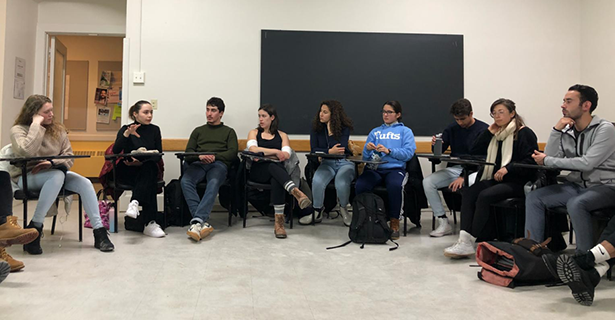From the migration crisis in the Mexico-US border to the mass Venezuelan exodus, hundreds of thousands of Latin Americans are on the move, escaping armed conflicts, human rights violations, dysfunctional governments, poor economies and climate change. Migration is a key component of Latin America, and the region faces the world’s largest displacement crisis. The Latin American Committee (LAC) decided to make migration its first theme for discussion, dividing the theme into three main topics:
- Venezuela's mass exodus.
- Gang violence in Central America.
- Climate change and natural disasters as causes for migration in Bolivia and Haiti.
Each subject was discussed individually during LAC’s weekly meetings, framed around curated readings- including essays, articles and videos that members read beforehand.
The discussion on the first topic - Venezuela’s mass exodus - was held on January 31st and attracted a large crowd due to its current relevance and global implications. Here, members explored the reasons behind Maduro’s rise to power and the ways in which Juan Guaidó could challenge the current regime, as well as the implications of transferring power. Members also discussed who should take responsibility for the mass migrations. How can Colombia receive thousands of immigrants without proper infrastructure? Should they close their borders? Will the influx of people trigger xenophobia and anti-immigration sentiments, or will Colombia continue to welcome people? How can the international community mitigate the crisis? Members argued that Colombia should not close its borders, as this would make the region more dangerous.
The second discussion, held on February 7th, focused on the effect gang violence has in increasing migration, namely in Central America. Countries with weak political structures and institutions tend to have higher incidence of gang violence as a result of their inability to enforce the rule of law and due to local corruption, thus making room for gangs to expand and proliferate.
Part of the reason why Central American countries have weak political systems roots from U.S. interventions and support of authoritarians as part of the Cold War. Many of these countries experience cycles of violence, which in turn lead to high levels of emigration to neighboring countries. Members agreed that the best solution to combat gang violence begins with a top-down government reform coupled with a reduction in corruption levels. In addition, members also debated whether “resource rich” countries / “countries of destiny” should offer working visas to immigrants. However, the chances that the US would give free visas is unlikely based on its current outlook on immigrants.
The last topic was discussed on February 14th and looked at the effects of migration following the earthquake in Haiti in 2012 and the natural phenomena El Niño and La Niña in South America. LAC debated that, while Haiti received a lot of international attention and aid, this aid was not effectively managed. Millions of dollars were lost, and, as time passed, the international community moved on to other issues.
Members called for longer, more sustainable aid from organizations such as the IMF, yet realized that the most important part is correcting Haiti’s methods of receiving aid. Members also discussed the need for a change in the UN’s definition for “refugee,” which currently does not include people emigrating due to climate change, as in the case of Bolivia, where farmers escape severe droughts.

